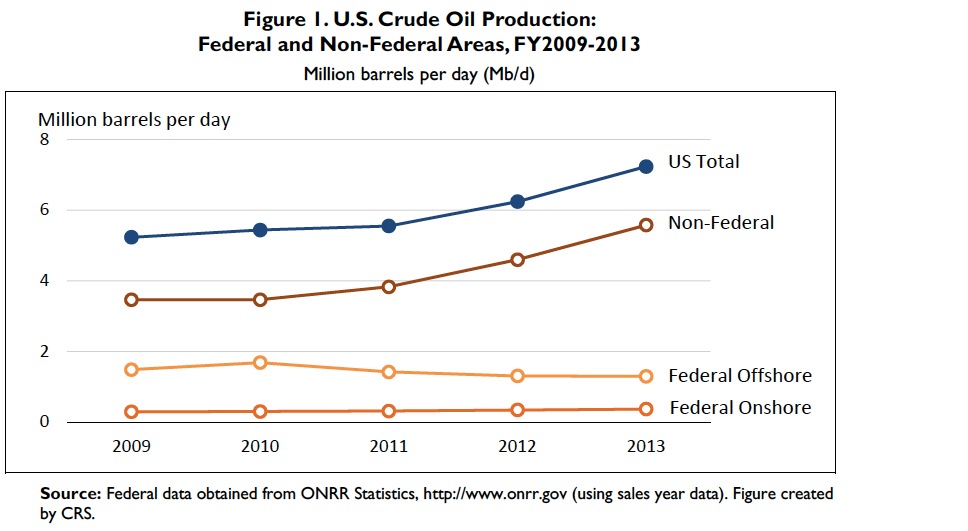CONGRESSIONAL RESEARCH SERVICE
Summary
In 2013, the price of oil averaged $98 per barrel (West Texas Intermediate spot price), up from $94 per barrel in 2012. Prices remain high in early 2014 (near $100 per barrel) and are projected by the Energy Information Administration (EIA) to average in the mid-$90 per barrel range through 2014. A number of proposals designed to increase domestic energy supply, enhance security, and/or amend the requirements of environmental statutes are before the 113th Congress. A key question in this discussion is how much oil and gas is produced in the United States each year and how much of that comes from federal versus non-federal areas. Oil production has fluctuated on federal lands over the past five fiscal years but has increased dramatically on nonfederal lands. Non-federal crude oil production has been rapidly increasing in the past few years partly due to favorable geology and the relative ease of leasing from private parties, rising by 2.1 million barrels per day (mbd) between FY2009-FY2013, causing the federal share of total U.S. crude oil production to fall by nearly 11%.
Natural gas prices, on the other hand, have remained low for the past several years, allowing gas to become much more competitive with coal for power generation. The shale gas boom has resulted in rising supplies of natural gas. Overall, annual U.S. natural gas production rose by about four trillion cubic feet (tcf) or 19% since FY2009, while production on federal lands (onshore and offshore) fell by about 28%. Natural gas production on non-federal lands grew by 33% over the same time period. The big shale gas plays are primarily on non-federal lands and are attracting a significant portion of investment for natural gas development.
The number of producing acres may or may not be a function of how many acres are leased, and the number of acres leased may or may not correlate to the amount of production, but in recent years, some members of Congress have proposed a $4/acre lease fee for non-producing leases. This proposal grew out of the efforts to open more public land and water (offshore) for oil and gas drilling and development when gasoline prices spiked in 2006-2008. Some in Congress noted that there were many leases they believed were not being developed in a timely fashion, while at the same time, others in Congress were pushing for greater access to areas off-limits (such as the Arctic National Wildlife Refuge (ANWR) and areas under leasing moratoria offshore). Higher rents for offshore leases were imposed by the Secretary of the Interior in 2009 to discourage holding unused leases and to move more leases into production, if possible.
Another major issue that Congress may seek to address is streamlining the processing of applications for permits to drill (APDs). Some members contend that this would be one way to help boost energy production on federal lands. After a lease has been obtained, either competitively or non-competitively, an APD must be approved for each oil and gas well. Despite the new timeline for review (under the Energy Policy Act of 2005, P.L. 109-58), it took an average of 307 days for all parties to process (approve or deny) an APD in 2011, up from an average of 218 days in 2006. The difference, however, is that in 2006 it took the Bureau of Land Management (BLM) an average of 127 days to process an APD, while in 2011 it took BLM 71 days. In 2006, the industry took an average of 91 days to complete an APD, but in 2011, industry took 236 days. The BLM stated in its FY2012 and FY2013 budget justifications that overall processing times per APD have increased because of the complexity of the process.
Download full version (PDF): U.S. Natural Gas Production
About the Congressional Research Service
www.loc.gov/crsinfo
“The Congressional Research Service (CRS) works exclusively for the United States Congress, providing policy and legal analysis to committees and Members of both the House and Senate, regardless of party affiliation. As a legislative branch agency within the Library of Congress, CRS has been a valued and respected resource on Capitol Hill for nearly a century.”
Tags: Congress, Congressional Research Service, CRS, Library of Congress, Natural Gas, Oil, Petroleum







 RSS Feed
RSS Feed